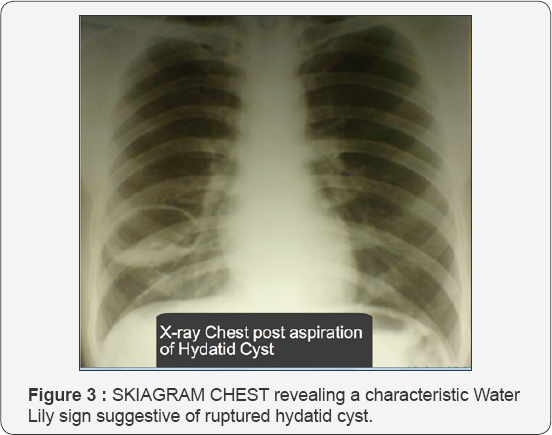Iatrogenically Ruptured Pulmonary Hydatid Cyst Presenting as Haemoptysis - A Case Report-Juniper publishers
JUNIPER PUBLISHERS-OPEN ACCESS INTERNATIONAL JOURNAL OF PULMONARY & RESPIRATORY SCIENCES
Abstract
A 35-year-old male patient presented to us with
complaint of massive haemoptysis. His chest radiograph revealed a
characteristic water lily sign indicative of ruptured hydatid cyst.
Patient then gave the history of inadvertent aspiration from the cyst by
a private practitioner. Cystic fluid on examination had showed plenty
of hooklets and scolices of Echinococcus granulosus. Diagnosis of
hydatidosis was further confirmed by serology. Patient was then put on
supportive treatment along with albendazole chemotherapy and he improved
on them suggestive of efficacy of albendazole even in case of
complicated hydatid cyst such as rupture.
Introduction
Haemoptysis is one of the most dreaded
manifestations of cardiopulmonary disease. Haemoptysis in adults is most
often caused by tuberculosis, bronchitis, bronchiectasis, trauma or
bronchogenic carcinoma [1].
We report here an unusual cause of massive haemoptysis, which was due
to a ruptured pulmonary hydatid localized in the lungs and was
misquandering as tuberculosis.
Case Report
A 28-year-old male patient was referred to us with
complaints of massive haemoptysis that followed inadvertent aspiration
of pulmonary cyst by a private practitioner. He further gave history of
chest pain and cough with expectoration, of two years' duration that got
aggravated following aspiration. He gave history of had taken
antibiotics and antitubercular drugs in the past without any clinical
improvement. He was non-smoker and nonalcoholic and had no history of
diabetes and hypertension. His family history was also not significant.
His general physical examination revealed pallor and weakness. His
hemoglobin was 10gram percent, total leukocyte count was 11,600
cells/mL, differential count was P71, L19, M2, E8, B0 and E.S.R.
(Westergreen) was 80mm/ hour. His X-ray chest (Figure 1) revealed a space-occupying lesion in lower zone of right hemi thorax. His CT Thorax (Figure 2)
revealed a cystic lesion in right lung. His new X-ray chest was carried
out and the aspirated fluid was sent for investigation. X-ray (Figure 3)
revealed a characteristic Water Lily sign suggestive of ruptured
hydatid cyst. Examination of the aspirated fluid showed hooklets,
scolices and fragments of cyst wall resembling Echinococcus granulosus.
Further serology was carried out to confirm the diagnosis. Antibodies to
Echinococcus were significantly positive (1:18) by indirect
haemagglutination test (IHA). Patient was ultimately started on high
dose of oral albendazole therapy. Patient has clinicoradiologically (Figure 4) improved as on albendazole therapy and is presently asymptomatic.




Larvae of the tapeworm Echinococcus cause
echinococcosis or hydatid disease. Four species are recognized but
Echinococcus granulosus causes the vast majority of infestations in
humans. Hydatid disease may involve any organ of the body. However due
to the effect of hepatic and pulmonary capillary sieves in containing
the larvae, approximately 65% to 70% cysts occur in the liver followed
by 15% to 30% in lungs. The remaining 3% to 5% cysts may be found
virtually anywhere but most commonly in the spleen, kidney, brain and
bones. Thus, liver and lungs are the two common sites of involvement in
hydatid disease. Concomitant involvement of both liver and lung may be
noticed in 10% of the cases [2], a condition given the name Hepatopulmonary Hydatidosis (HPH Disease) [3].
Isolated primary pulmonary hydatidosis with normal liver and no other
sites of localization of the cyst is an unusual finding. Pulmonary
echinococcal cysts are usually solitary but may be multiple in 20-30%
cases [4]. It is further more common in children and less common in adults [5].
Hydatid disease may present with varied clinical
manifestations. Involvement of lung by hydatid cyst may result in chest
pain, chronic cough, expectoration, dyspnea, eosinophillic pneumonitis,
pneumothorax, pleural effusion, parasitic lung embolism and even
haemoptysis [6].
The mechanism of haemoptysis as in pulmonary hydatidosis may be due to
pressure erosion of a bronchus or an obstructive effect with a bronchial
infection. There may be occasional rupture of cyst into the bronchus
resulting in massive haemoptysis as seen in the present case [7,8]. Underlying etiology for haemoptysis may be unknown in 20% of the cases [9].
Rupture of hydatid cyst can occur spontaneously and sometimes can be an
initial manifestation of the occult disease. However it more commonly
occurs after accidental aspiration of pulmonary hydatid cyst as in our
case. In recent years percutaneous aspiration has been reported to be
safe as the treatment of pulmonary hydatid cyst [10].
However it should be done under albendazole coverage
and they should be punctured under US or CT guidance in the presence of
an anesthesiologist who intervenes in cases of allergic manifestations
or anaphylactic shock. But in this case aspiration was done accidentally
and in unguided manner. Such a procedure has long been discouraged
because of risks of anaphylactic shock and spillage of the fluid and
this may even be lethal. Although surgery was earlier considered to be
essential but now chemotherapy is considered as to be effective in
treating pulmonary hydatidosis even if complications such as rupture
occur. Galankis E et al. [11]
reports a case of rupture of cyst in an 11-year-old boy with bacterial
super infection who was treated with 3 courses of albendazole and
recovered fully, uneventfully and without relapse. Even rupture
following treatment with albendazole may occur [11,12]. However continuing albendazole in such cases also led to eventual cure of the disease [12].
Whether albendazole really increases the chances of cyst rupture
remains to be answered. However, it is recommended that Albendazole
should be continued even if the patient develops rupture of the cyst [13].
It should also be used in setting where the fluid leakage is not
obvious like during surgery to minimize or eliminate the chances of
recurrence and dissemination.
To know more about Open Access International
Journal of Pulmonary & Respiratory Sciences please click on: https://juniperpublishers.com/ijoprs/index.php
To know more about Open access Journals
Publishers please click on : Juniper Publishers
To know more about juniper publishers: https://juniperpublishers.business.site/
Comments
Post a Comment